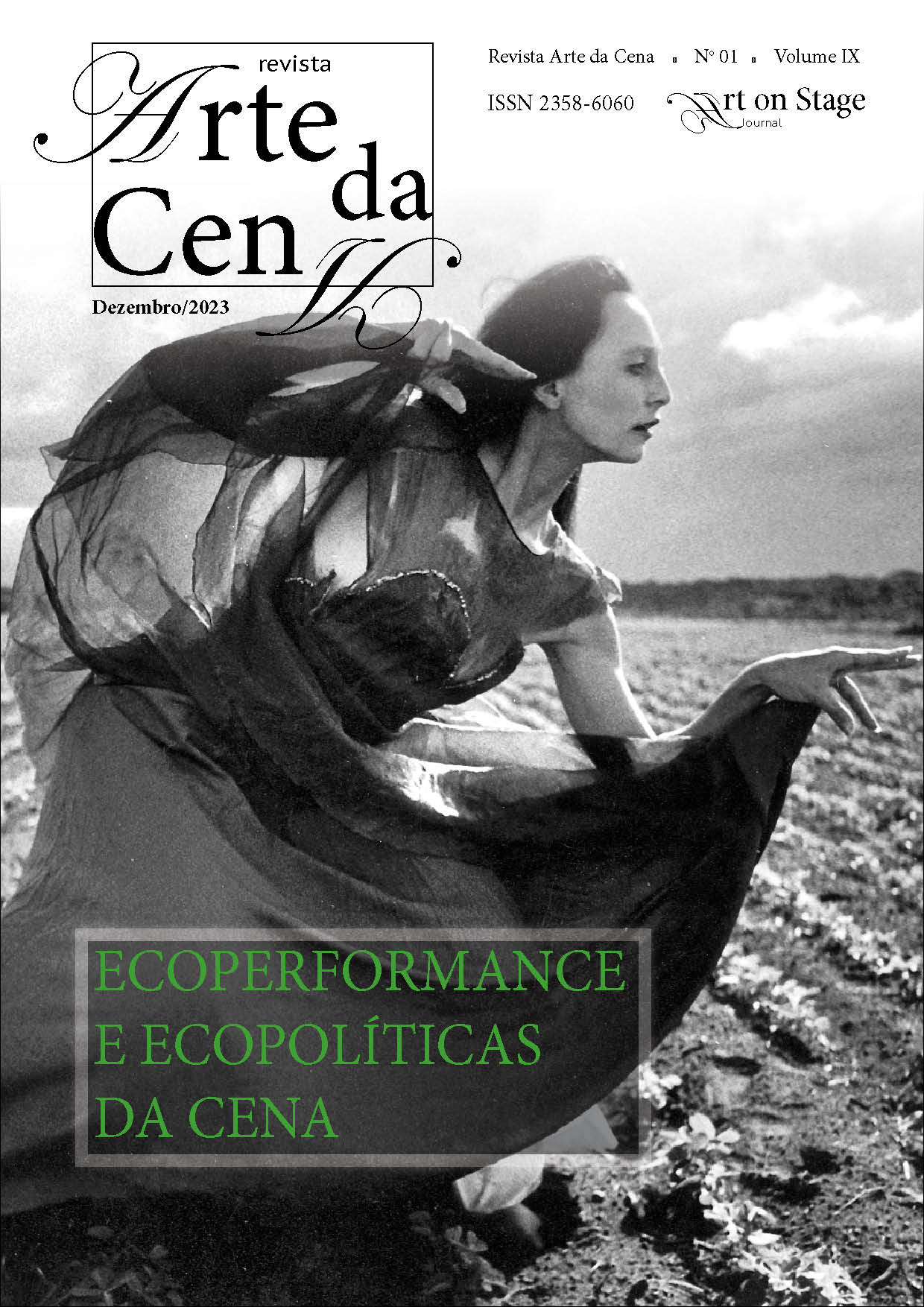THE AUTONOMY OF LANDSCAPE IN THE WORK OF PHILIPPE QUESNE
DOI:
https://doi.org/10.5216/ac.v9i1.76525Abstract
In his company Vivarium Studio and then at Nanterre-Les Amandiers, Philippe Quesne examines the relationship between art and the living world. He places onstage the branches of trees, stones, animals and atmospheric phenomena on a par with human beings. His work accompanies and questions a conceptual revolution. The living world, both plant and animal, is not for him a mere object. His theatre gives it the status of a subject. We will see how this onstage revision in the hierarchy of living creatures is based on the theory of landscape from the Renaissance to the present day, in particular by analysing his show Caspar Western Friedrich and his “mole trilogy” (Swamp Club, Crash Park and La nuit des taupes).
Downloads
References
Books:
DESCOLA, Philippe. Par-delà de nature et culture. Paris: Gallimard, 2005.
DIDI-HUBERMAN, Georges. Phasmes. Essais sur l'apparition. Paris: Les éditions de minuit, 1998.
LATOUR, Bruno. Down to earth: politics in the new climatic regime. Cambridge: Polity, 2018.
LATOUR, Bruno. Où atterrir? Comment sórienter en politique. Paris: La Découverte, 2017.
LE SCANFF, Yvon. Paysage romantique et l'expérience du sublime. Seyssel: Éditions Champ Vallon, 2007.
OVID. The Metamorphoses. Traduction by Allen Mandelbaum. London: Everyman's Library, 2013.
PANOFSKY, Erwin. La perspective comme forme symbolique et autres essais. Paris: Les éditions de Minuit, 1976.
RANCIÈRE, Jacques. Le temps du paysage: aux origines de la révolution esthétique. Paris: La Fabrique, 2020.
SABBATTINI, Nicola. Pratique pour fabriquer scènes et machines de théâtre. Lausanne: Ides et Calendes, 2015.
TSING, Anna. The Mushroom at the End of the World. New Jersey: Princeton University Press, 2015.
WEEMANS, Michel; FALKENBURG Reinert L. Pieter Brueghel. Paris: Hazan, 2018.
Journals and Magazines:
BELLET, Catherine. Dossier pédagogique pour La Mélancolie des dragons: conception, mise en scéne et scénographie Philippe Quesne. CDR Tours, 2015. Available in: https://cdntours.fr/sites/default/files/spectacles/dossier_pedagogique_la_melancolie_des_dragons_0.pdf
BOON, Karel G. Patientia dans les gravures de la Réforme aux Pays-Bas. Revue de l’Art, 56 (1982): 7 - 24.e l'Art, 56 (1982): 7 - 24.
HACHE, Émilie. Alpi, d’Armin Linke. Getting back to the wrong nature. In: LEJEALLE, Catherine, et. al. Sciences de la société, 87|2012, 114-127.
LAVIGNE, Aude. Dossier pédagogique autour de Philippe Quesne et du Vivarium Studio, 2009. Available in: https://mediation.centrepompidou.fr/education/ressources/ENS-artsdelascene-theatre/quesne/quesne_00.html
MAMADNAZARBEKOVA, Kamila. Режиссер Филипп Кен: Чтобы спасти человека, ему на помощь должны прийти звери. Snob Magazine, 19/09/2014. Available in: https://snob.ru/selected/entry/81192/
Films:
Trash Humpers. Direction by Harmony Korine. Nashville: Alcove Entertainment and Warp Films, 2009.
Alpi. Direction by Armin Linke. Berlin: Armin Linke Production, 2011.
Others
AUDEN, W. H. “Musée des Beaux-Arts”. Available in: https://www.poetrybyheart.org.uk/poems/musee-des-beaux-arts/
DE LOISY, Jean. Programme on France Culture: “Pieter Brueghel, anthropomorphiste de la nature”, broadcast on 04/08/2019 (first broadcast on 11/11/2018), with Michel Weemans and Sandrine Vézilier-Dussart.
Meeting: “Huts! Poetic Resistance and Political Construction” between Phia Ménard, Philippe Quesne, Gwenaël Morin, Marielle Macé, Christophe Laurence and Ludovic Lamant, moderated by Camille Louis as part of the “Possible worlds” cycle, posted online on 01/06/2019 by the Nanterre-Amandiers communications team.
Downloads
Published
How to Cite
Issue
Section
License
Copyright (c) 2023 Kamila Mamadnazarbekova

This work is licensed under a Creative Commons Attribution-NonCommercial 4.0 International License.
The Art on Stage Journal uses the Creative Commons - Attribution-Non-Commercial 4.0 International license as a basis for transferring rights, for open access journals (Open Archives Initiative - OAI).
Authors who publish in this journal agree with the following terms:
1) Authors retain the copyright and grant the Art on Stage Journal the right to first publication, with the work simultaneously licensed under the Creative Commons Attribution Non Commercial License.
2) Authors are authorized to assume additional contracts separately, for non-exclusive distribution of the version of the work published in this Journal (eg, publishing in institutional repository or as a book chapter), with acknowledgment of authorship and initial publication in this journal.
3) Authors are allowed and encouraged to publish and distribute their work online (eg in institutional repositories or on their personal page) at any point before or during the editorial process, provided that the reference to the place of publication is cited, that is, the electronic address / reference of Art on Stage Journal.
4) The authors of the works published in the Art on Stage are expressly responsible for their content.
5) Authors will not be paid for publication of works in the Art on Stage Journal.



